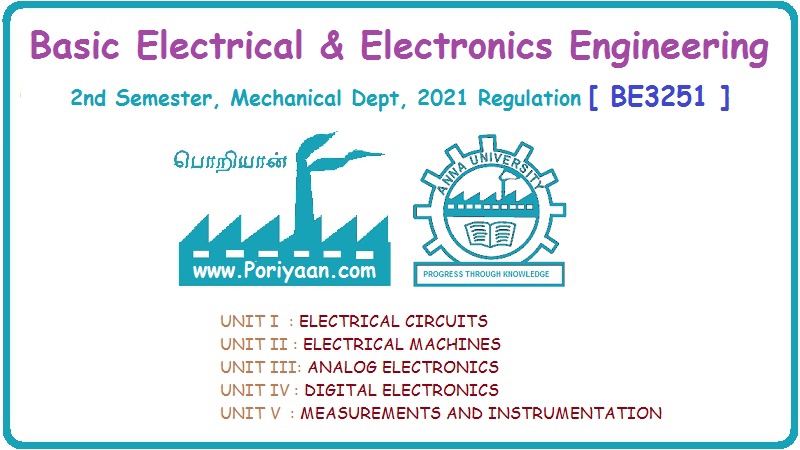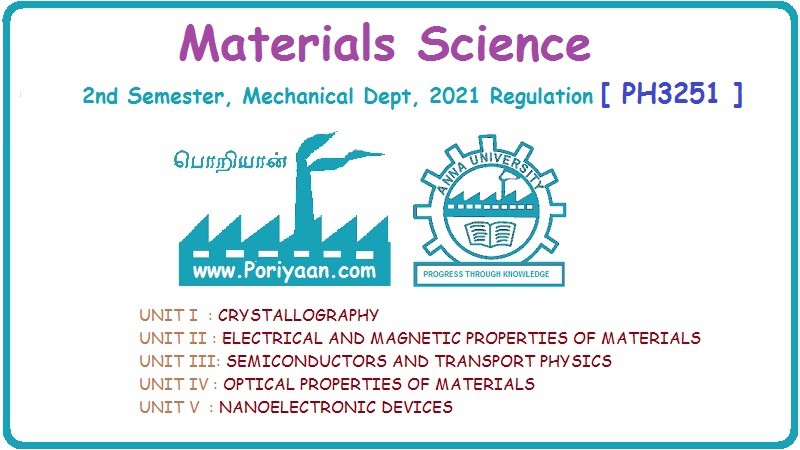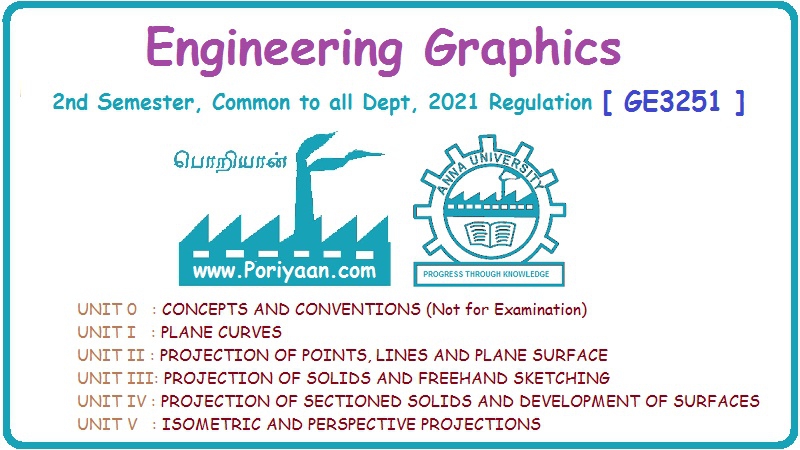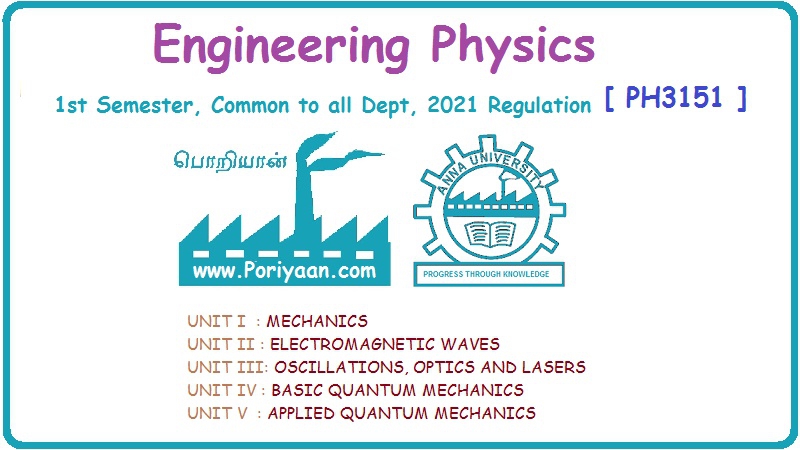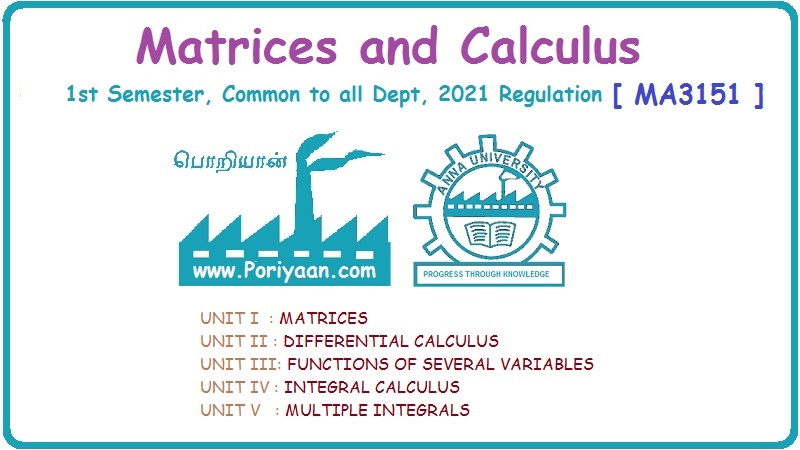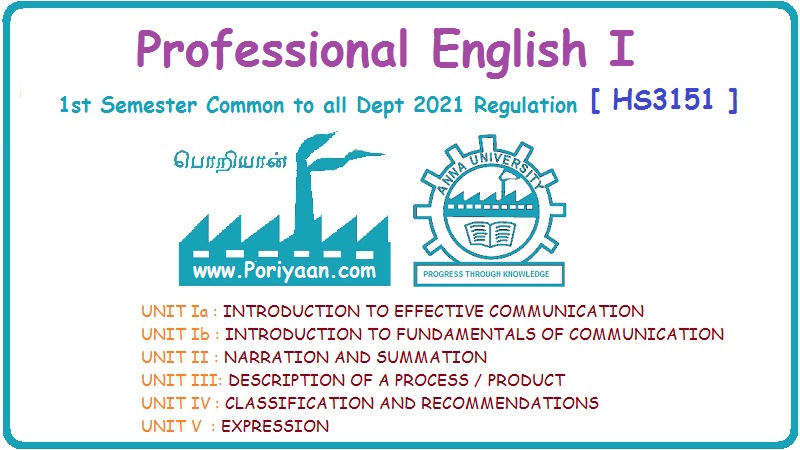Materials Science
PH3251 2nd semester Mechanical Dept | 2021 Regulation

2021 regulation - 1st year, 2nd semester paper for Mechanical Department. Subject Code: PH3251, Subject Name: Materials Science, Batch: 2021, 2022, 2023, 2024. Institute: Anna University Affiliated Engineering College, TamilNadu. This page has Materials Science study material, notes, semester question paper pdf download, important questions, lecture notes.
PDF Download Links
Materials Science
- Crystallography
- Crystal Structures
- Body-centred Cubic (BCC) Structure
- Face-centred Cubic (FCC) Structure
- Hexagonal close-packed (HCP) Structure
- Directions in Crystal
- Planes in Crystals
- Linear Density and Planar Density
- Anna University Solved Problems [lattice constant]
- Crystal Imperfections
- Line Defects or Dislocations
- Burger's Vectors
- Elastic Strain Energy
- Plastic Deformation Mechanisms
- Slip Systems in FCC & BCC Crystals
- Polymorphism
- Phase changes or Transformations
- Nucleation and Growth
- Homogeneous or Self-Nucleation
- Heterogeneous Nucleation
- Anna University Solved Problems
- 2 Marks Question & Answers
- Additional 2 Marks Question & Answers
- 16 Marks Questions, Assignment Problems
- Electrical Properties of Materials
- Classical Free Electron (CFE) Theory of Metals
- Expression for Electrical Conductivity of a Metal (Derivation)
- Expression for Thermal Conductivity of a Metal (Derivation)
- Anna University Solved Problems [Lorentz number]
- Quantum Free Electron (GFE) Theory
- Degenerate States
- Tunneling
- Fermi-Dirac Statistics
- Anna University Solved Problems [Fermi distribution function]
- Density of Energy States
- Electron in Periodic Potential
- Energy Bands in Solids
- Tight Binding Approximation
- Effective Mass of Electron and Hole
- Concept of Hole: (or) Effective or Negative Mass of Electron
- Anna University Solved Problems
- 2 Marks Question & Answers
- Additional 2 Marks Question & Answers
- 16 Marks Questions, Assignment Problems
- Magnetic Properties of Materials
- Classification of Magnetic Materials
- Diamagnetic Effect
- Paramagnetic Effect
- Paramagnetism in the Conduction Electrons in Metals
- Ferromagnetic Effect
- Exchange Interaction and Ferromagnetism
- Quantum Interference Devices: SQUID, GMR
- Giant Magneto Resistance (GMR) Devices Sensor Spin Valve
- Anna University Solved Problems
- 2 Marks Question & Answers
- Anna University Solved Problems
- 16 Marks Questions
- Semiconductors based on Electrical resistance
- Direct and Indirect Band gap Semiconductors
- (i) Intrinsic Semiconductors
- Energy Band Diagram for intrinsic semiconductor
- Carrier Concentration in Intrinsic Semiconductors
- (ii) Extrinsic or Impure Semiconductors
- Carrier Concentration in n-Type Semiconductors [Derivation]
- Concentration of holes in valence band of p-type semiconductors [derivation]
- Variation of Carrier Concentration with Temperature and Impurity
- Carrier Transport in Semiconductor Mobility
- Mobility
- Drift and Diffusion
- Hall effect
- Hall Devices
- Schottky Diode
- Ohmic Contacts
- Anna University Solved Problems
- 2 Marks Question & Answers
- Additional 2 Marks Question & Answers
- 16 Marks Questions, Assignment Problems
- Optical Properties of Materials
- Classification of Optical Materials
- Optical Processes in Semiconductors
- Absorption and Emission of Light in Semiconductors
- Charge Injection and Radiative Recombination
- Carrier Generation and Recombination Processes
- Optical Absorption, Loss and Gain
- Optical Processes in Quantum Wells
- Optoelectronic Devices
- Light Detectors
- Solar Cell
- Light Emitting Diode (LED)
- Laser Diodes
- Organic Semiconductors: Optical Processes and Devices
- Excitonic State & Organic Light Emitting Diode (OLED)
- Electro-Optic Effects
- Non Linear Optics
- Different electro optic modulators
- Optical (photonic) Switching
- Plasmonics
- 2 Marks Question & Answers
- 16 Marks Questions
- Nanoelectronic Devices
- Quantum Confinement
- Quantum structures (quantum wells, wires and dots)
- Zener - bloch oscillations
- Resonant Tunneling
- Single Electron Phenomena
- Single Electron Transistor (SET)
- Mesoscopic Structure
- Quantum Interference Effect
- Spintronics
- Carbon nanotubes (CNT)
- Properties of CNTs (Carbon NanoTubes)
- Applications of Carbon Nanotubes (CNTs)
- Semiconductor for Photonic Structures
- 1d photonic crystals
- 2D photonic crystals
- 3D photonic crystals
- 2 Marks Question & Answers
- 16 Marks Questions
PDF Download Links
Materials Science
Unit I: Crystallography
- Crystallography
- Crystal Structures
- Body-centred Cubic (BCC) Structure
- Face-centred Cubic (FCC) Structure
- Hexagonal close-packed (HCP) Structure
- Directions in Crystal
- Planes in Crystals
- Linear Density and Planar Density
- Anna University Solved Problems [lattice constant]
- Crystal Imperfections
- Line Defects or Dislocations
- Burger's Vectors
- Elastic Strain Energy
- Plastic Deformation Mechanisms
- Slip Systems in FCC & BCC Crystals
- Polymorphism
- Phase changes or Transformations
- Nucleation and Growth
- Homogeneous or Self-Nucleation
- Heterogeneous Nucleation
- Anna University Solved Problems
- 2 Marks Question & Answers
- Additional 2 Marks Question & Answers
- 16 Marks Questions, Assignment Problems
Unit II(a): Electrical Properties of Materials
- Electrical Properties of Materials
- Classical Free Electron (CFE) Theory of Metals
- Expression for Electrical Conductivity of a Metal (Derivation)
- Expression for Thermal Conductivity of a Metal (Derivation)
- Anna University Solved Problems [Lorentz number]
- Quantum Free Electron (GFE) Theory
- Degenerate States
- Tunneling
- Fermi-Dirac Statistics
- Anna University Solved Problems [Fermi distribution function]
- Density of Energy States
- Electron in Periodic Potential
- Energy Bands in Solids
- Tight Binding Approximation
- Effective Mass of Electron and Hole
- Concept of Hole: (or) Effective or Negative Mass of Electron
- Anna University Solved Problems
- 2 Marks Question & Answers
- Additional 2 Marks Question & Answers
- 16 Marks Questions, Assignment Problems
Unit II(b): Magnetic Properties of Materials
- Magnetic Properties of Materials
- Classification of Magnetic Materials
- Diamagnetic Effect
- Paramagnetic Effect
- Paramagnetism in the Conduction Electrons in Metals
- Ferromagnetic Effect
- Exchange Interaction and Ferromagnetism
- Quantum Interference Devices: SQUID, GMR
- Giant Magneto Resistance (GMR) Devices Sensor Spin Valve
- Anna University Solved Problems
- 2 Marks Question & Answers
- Anna University Solved Problems
- 16 Marks Questions
Unit III: Semiconductors and Transport Physics
- Semiconductors based on Electrical resistance
- Direct and Indirect Band gap Semiconductors
- (i) Intrinsic Semiconductors
- Energy Band Diagram for intrinsic semiconductor
- Carrier Concentration in Intrinsic Semiconductors
- (ii) Extrinsic or Impure Semiconductors
- Carrier Concentration in n-Type Semiconductors [Derivation]
- Concentration of holes in valence band of p-type semiconductors [derivation]
- Variation of Carrier Concentration with Temperature and Impurity
- Carrier Transport in Semiconductor Mobility
- Mobility
- Drift and Diffusion
- Hall effect
- Hall Devices
- Schottky Diode
- Ohmic Contacts
- Anna University Solved Problems
- 2 Marks Question & Answers
- Additional 2 Marks Question & Answers
- 16 Marks Questions, Assignment Problems
Unit IV: Optical Properties of Materials
- Optical Properties of Materials
- Classification of Optical Materials
- Optical Processes in Semiconductors
- Absorption and Emission of Light in Semiconductors
- Charge Injection and Radiative Recombination
- Carrier Generation and Recombination Processes
- Optical Absorption, Loss and Gain
- Optical Processes in Quantum Wells
- Optoelectronic Devices
- Light Detectors
- Solar Cell
- Light Emitting Diode (LED)
- Laser Diodes
- Organic Semiconductors: Optical Processes and Devices
- Excitonic State & Organic Light Emitting Diode (OLED)
- Electro-Optic Effects
- Non Linear Optics
- Different electro optic modulators
- Optical (photonic) Switching
- Plasmonics
- 2 Marks Question & Answers
- 16 Marks Questions
Unit V: Nanoelectronic Devices
- Nanoelectronic Devices
- Quantum Confinement
- Quantum structures (quantum wells, wires and dots)
- Zener - bloch oscillations
- Resonant Tunneling
- Single Electron Phenomena
- Single Electron Transistor (SET)
- Mesoscopic Structure
- Quantum Interference Effect
- Spintronics
- Carbon nanotubes (CNT)
- Properties of CNTs (Carbon NanoTubes)
- Applications of Carbon Nanotubes (CNTs)
- Semiconductor for Photonic Structures
- 1d photonic crystals
- 2D photonic crystals
- 3D photonic crystals
- 2 Marks Question & Answers
- 16 Marks Questions
PDF Download Links

PH3251
MATERIALS SCIENCE
COURSE OBJECTIVES:
• To make the students to understand the
basics of crystallography and its importance in studying materials properties.
• To understand the electrical properties of materials including free electron theory, applications of quantum mechanics and magnetic materials.
• To instil knowledge on physics of
semiconductors, determination of charge carriers and device applications
• To establish a sound grasp of knowledge
on different optical properties of materials, optical displays and applications
• To inculcate an idea of significance of
nano structures, quantum confinement and ensuing nano device applications.
UNIT - I
CRYSTALLOGRAPHY
Crystal
structures: BCC, FCC and HCP – directions and planes - linear and planar densities
– crystal imperfections- edge and screw dislocations – grain and twin boundaries
- Burgers vector and elastic strain energy- Slip systems, plastic deformation
of materials - Polymorphism – phase changes – nucleation and growth –
homogeneous and heterogeneous nucleation.
UNIT - II
ELECTRICAL AND MAGNETIC PROPERTIES OF MATERIALS
Classical
free electron theory - Expression for electrical conductivity – Thermal
conductivity, expression - Quantum free electron theory :Tunneling – degenerate
states – Fermi- Dirac statistics – Density of energy states – Electron in
periodic potential – Energy bands in solids – tight binding approximation -
Electron effective mass – concept of hole. Magnetic materials: Dia, para and ferromagnetic
effects – paramagnetism in the conduction electrons in metals – exchange
interaction and ferromagnetism – quantum interference devices – GMR devices.
UNIT - III
SEMICONDUCTORS AND TRANSPORT PHYSICS
Intrinsic
Semiconductors – Energy band diagram – direct and indirect band gap
semiconductors – Carrier concentration in intrinsic semiconductors – extrinsic
semiconductors - Carrier concentration in N-type & P-type semiconductors –
Variation of carrier concentration with temperature – Carrier transport in
Semiconductors: Drift, mobility and diffusion – Hall effect and devices – Ohmic
contacts – Schottky diode.
UNIT - IV
OPTICAL PROPERTIES OF MATERIALS
Classification
of optical materials – Optical processes in semiconductors: optical absorption
and emission, charge injection and recombination, optical absorption, loss and
gain. Optical processes in quantum wells – Optoelectronic devices: light
detectors and solar cells – light emitting diode – laser diode - optical processes
in organic semiconductor devices –excitonic state – Electro-optics and
nonlinear optics: Modulators and switching devices – plasmonics.
UNIT - V
NANOELECTRONIC DEVICES
Quantum
confinement – Quantum structures – quantum wells, wires and dots – Zener-Bloch oscillations
– Resonant tunneling – quantum interference effects - mesoscopic structures –
Single electron phenomena – Single electron Transistor. Semiconductor photonic
structures – 1D, 2D and 3D photonic crystal. Active and passive optoelectronic
devices – photo processes – spintronics – carbon nanotubes: Properties and
applications.
TOTAL:
45 PERIODS
COURSE OUTCOMES:
At
the end of the course, the students should be able to
• know basics of crystallography and its
importance for varied materials properties
• gain knowledge on the electrical and
magnetic properties of materials and their applications
• understand clearly of semiconductor
physics and functioning of semiconductor devices
• understand the optical properties of
materials and working principles of various optical devices
• appreciate the importance of functional
nanoelectronic devices.
TEXT BOOKS:
1.
V.Raghavan. Materials Science and Engineering: A First Course, Prentice Hall
India Learning Private Limited, 2015.
2.
S.O. Kasap, Principles of Electronic Materials and Devices, Mc-Graw Hill, 2018.
3.
Jasprit Singh, Semiconductor Devices: Basic Principles, Wiley (India), 2007.
4.
Jasprit Singh, Semiconductor Optoelectronics: Physics and Technology, Mc-Graw
Hill India (2019)
5.
G.W.Hanson. Fundamentals of Nanoelectronics. Pearson Education (Indian
Edition), 2009.
REFERENCES:
1.
R.Balasubramaniam, Callister’s Materials Science and Engineering. Wiley (Indian
Edition), 2014.
2.
Wendelin Wright and Donald Askeland, Essentials of Materials Science and
Engineering, CL Engineering, 2013.
3.
Robert F.Pierret, Semiconductor Device Fundamentals, Pearson, 2006
4.
Pallab Bhattacharya, Semiconductor Optoelectronic Devices, Pearson, 2017
5.
Ben Rogers, Jesse Adams and Sumita Pennathur, Nanotechnology: Understanding
Small Systems, CRC Press, 2017.
Materials Science: Unit I: Crystallography,, Materials Science: Unit II(a): Electrical Properties of Materials,, Materials Science: Unit II(b): Magnetic Properties of Materials,, Materials Science: Unit III: Semiconductors and Transport Physics,, Materials Science: Unit IV: Optical Properties of Materials,, Materials Science: Unit V: Nanoelectronic Devices 2nd Semester Mechanical Dept 2021 Regulation : PH3251 2nd semester Mechanical Dept | 2021 Regulation Materials Science
